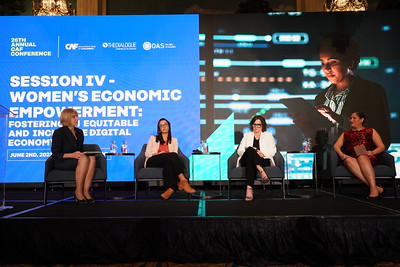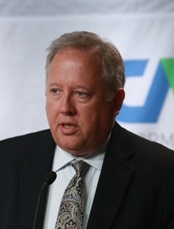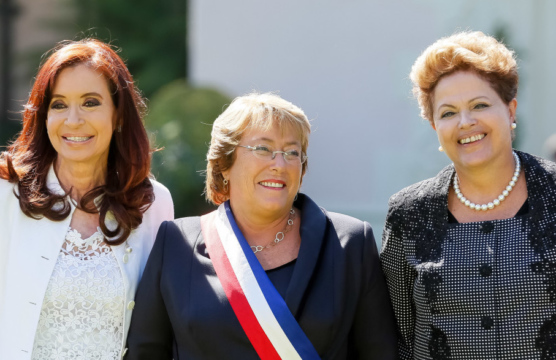What Roles are Women Playing in Mexico’s Drug War?
What roles are women playing in Mexico’s brutal drug trafficking war?
The fourth session of the 26th Annual CAF Conference on June 1-2, 2023, “Women’s Economic Empowerment – Fostering an Equitable and Inclusive Digital Economy,” focused on women’s inclusion in the digital transformation, discussing methods to bridge the digital divide between men and women by investing in digital upskilling, online financial management services and social services, and entrepreneurship programs. The Inter-American Dialogue, CAF-Development Bank of Latin America and the Caribbean, and the Organization of American States convened Mariana Costa, co-founder & CEO of Laboratoria and member of the Inter-American Dialogue, Tania Banens, vice president for products, sustainability, financial inclusion & innovation at Mastercard, and Priscila Villanueva, digital transformation expert at LEAD University in Costa Rica for a discussion on these important issues moderated by Ana Maria Baiardi, manager of gender, inclusion and diversity at CAF–Development Bank of Latin America and the Caribbean and Former Minister of Women of Paraguay. Baiardi kicked off the discussion by providing the context for gender inequality in Latin America and the Caribbean. In the region, 27 percent of women do not have their own income, compared to 11 percent of men; for every 100 men living in poverty, there are 116 women; and women spend three times more hours than men in non-remunerated care and household duties, contributing to an income gap of as much as 30 percent in some countries. Despite women’s growing access to education, Baiardi added, this has not translated into participation in the labor market to the same extent.
Panelists began by recounting the barriers they have faced in their personal and professional experiences. Villanueva identified four major obstacles. The first is unconscious bias, which perpetuates stereotypes and encourages certain types of jobs according to gender. The second is women’s assumed role as caregivers, which limits women’s ability to participate in the labor market. The third is financial support, as women often have a harder time accessing credit both for structural reasons and the aforementioned biases. The final obstacle, Villanueva said, is a lack of access to technological infrastructure, as many women across the region do not even have access to smartphones or computers. Despite these, Villanueva stressed that there are important pillars – including education and technology – on which to build on for the future.
One of the main barriers for Banens, from the payments industry perspective, is financial inclusion. This means not just improving access to financial products but ensuring that, once they open a bank account, women are actually using the financial instruments provided. She also expanded on the idea of gender bias in the payments business, with studies showing that women have better credit scores and better savings rates than men, but women get lower loan amounts and have less access to credit products than men do. Additionally, Banens said, research demonstrates that when female entrepreneurs and small business owners are given the same financial opportunities as men, global GDP could grow by US$5 trillion. A key component for the financial inclusion of women is also creating products that work for women, which she outlined as the third major barrier. Many of the existing financial solutions are products created by and for men and must be updated to include features and benefits designed with women’s experience in mind, Banens added.
This is something that certainly characterizes the technology industry, Costa said. Women are a marked minority of the people constructing and designing technological developments, which means women’s perspective is often excluded from the creation process of products and services that permeate every aspect of society. Costa emphasized two other barriers for women’s economic empowerment in Latin America and the Caribbean. The first relates to care duties, which disproportionally fall on women. This is in part because governments in the region have not prioritized building care systems that alleviate this burden and allow women the flexibility to join the labor market, but also because of existing cultural biases. This in turn encourages corporate cultures and organizational designs that favor men’s experiences over women’s, limiting the latter’s ability to advance to leadership positions to the same extent as men – the second barrier Costa identified.
Turning to the ways in which the region is addressing the digital gender gap, Banens outlined Mastercard’s gender agenda, which is based on three pillars: 1) markets, which is about offering gender-conscious products and solutions; 2) people, with a focus on how gender is addressed inside the firm; and 3) society, which encompasses the work the company does to influence broader digitalization and other initiatives. In Latin America and the Caribbean, nearly 99 percent of all businesses are micro and small businesses. Mastercard has committed to connecting 25 million micro and small business to the digital economy, Banens said, by offering a suite of solutions that are specific to small-business entrepreneurs as well as products specifically designed for women. This includes features that help women and their families’ well-being, with a focus on health, childcare, and education, as well as mentoring and training services for women entrepreneurs. In addition, the company has launched programs that seek to generate interest in technology and STEM more broadly, especially among young girls.
Costa then commented that an important element to consider when talking about bridging the digital gender gap is not only access to technology, but secure access to technology. As in other aspects of society, the digital transformation has differentiated gender impacts, with women facing, for example, a particular type of online violence. That is why it is so important to have women participate in the creation of these technologies, Costa reiterated. Greater representation of women within the technology industry can also help break gender stereotypes and create women’s networks to increase their participation on this front of the digital economy, she added.
Villanueva emphasized that every actor has a role to play in bridging the digital divide, including individuals themselves, civil society, NGOs, and the private and public sectors. In this regard, initiatives affording women the opportunity to develop entrepreneurial and leadership skills are important components, but they must be coupled with gender trainings for high-level officials and business leaders, including men, who also have a fundamental role in advancing women’s economic empowerment.
Looking ahead, Costa stressed the importance of ensuring gender continues to be a priority area. Every actor – individuals, families, societies, public institutions, multilateral organizations, and private companies – must work to maintain a gender agenda despite the progress of recent years. For Banens, the key word for bridging the digital divide is “partnership.” The challenge is to think outside the box and forge alliances with traditional and non-traditional partners, including between the financial industry and telecommunications companies and service providers, to create entire ecosystems that incorporate women, Banens said. For Villanueva, there are three fundamental components – education, technology, and partnerships – to think about for the future. Baiardi closed the session with a call for alliances among all stakeholders to address gender as a transversal issue that impacts every aspect of women’s lives.
What roles are women playing in Mexico’s brutal drug trafficking war?
The Inter-American Democratic Charter is a watershed in how the region understands democracy.
Despite making significant gains in government and politics, women continue to face structural barriers.
 Jay Mallin
Jay Mallin

 Video
Video